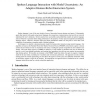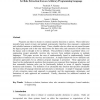136 search results - page 9 / 28 » Describing Additive Fluents in Action Language C |
HAPTICS
2002
IEEE
14 years 19 days ago
2002
IEEE
We present the results of using Hidden Markov Models (HMMs) for automatic segmentation and recognition of user motions. Previous work on recognition of user intent with man/machin...
OOPSLA
2005
Springer
14 years 1 months ago
2005
Springer
A number of effective error detection tools have been built in recent years to check if a program conforms to certain design rules. An important class of design rules deals with s...
POPL
2010
ACM
14 years 2 months ago
2010
ACM
Message-passing is an attractive thread coordination mechanism because it cleanly delineates points in an execution when threads communicate, and unifies synchronization and comm...
CONNECTION
2008
13 years 7 months ago
2008
Spoken language is one of the most intuitive forms of interaction between humans and agents. Unfortunately, agents that interact with people using natural language often experienc...
COMPSAC
2002
IEEE
14 years 20 days ago
2002
IEEE
Programs use rules to dictate or constrain specific decisions or actions. These rules have typically been tested, revised, and updated continuously; therefore, they represent a su...


